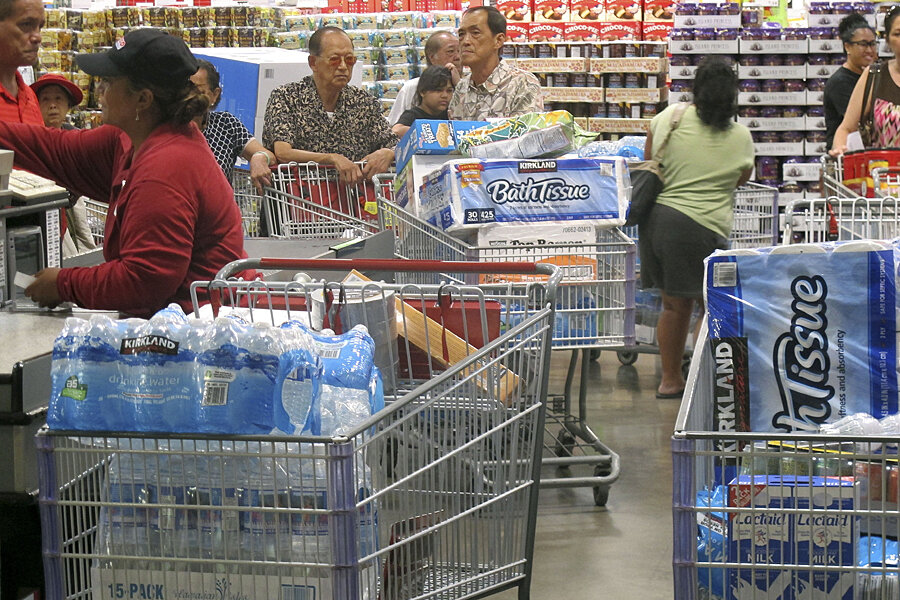Hawaii braces for hurricane Iselle, tropical storm Julio
Loading...
Hurricane Iselle and tropical storm Julio were heading west across the Pacific Ocean toward the tourist haven of Hawaii Wednesday, where officials announced school closures and warned visitors and residents to prepare.
High winds, heavy rain, sea surges, and flash floods were forecast.
Hurricane Iselle was about 860 miles (1,384 km) east of Hilo, on the Island of Hawaii, moving west-northwest at 13 miles per hour (21 km per hour) with maximum sustained winds of 100 mph (161 kph), the National Hurricane Center said on Wednesday.
"Iselle is moving toward the west-northwest near 13 mph," according to the latest update from the National Weather Service's Central Pacific Hurricane Center. "This general motion is expected to continue through Thursday, with a slight increase in forward speed. On this forecast track, the outer winds of Iselle may reach the easternmost Hawaiian islands early Thursday afternoon."
Residents were stocking up on basics as authorities in Honolulu advised them to prepare a seven-day disaster supply kit. The hurricane was forecast to weaken over the next 48 hours, the NHC center said.
Further east over the Pacific, Tropical Storm Julio was about 1,290 miles (2,076 km) from Baja California in Mexico and also expected to continue moving west-northwest through Thursday, the NHC said on Wednesday.
That storm was moving at 15 mph (24 kph) and has maximum sustained wind speeds of 65 mph (100 kph), it said.
Shoppers in Honolulu waited in line at supermarkets with carts full of bottled water, batteries and nonperishable food items.
"With Hawaii's remoteness, it could be as long as a week before a full disaster relief operation can be initiated," the department said in a statement late on Monday.
Honolulu school teacher Gina Nakahodo said she had felt calm about the situation, until she reached the empty water aisle of her local grocery store early on Tuesday.
"We've had so many storms that have passed us by, but with these two back to back you begin to worry. Then all of the sudden the aisles are empty and there's no water and it makes your heart pound a little," Nakahodo said.
She said she talked to a couple visiting from California, and told them everything was going to be OK. "But in the back of my mind I'm wondering, 'what's going to happen?'," she said.
The Coast Guard warned people to prepare for the onset of heavy weather by Thursday, with thehurricane and tropical storm expected to generate extreme sea conditions, storm surge and surf of 10 to 15 feet (3 to 4.6 meters) throughout the island chain.
The National Weather Service issued a flash flood watch from early Thursday to early Saturday, withHurricane Iselle expected to bring heavy rains to the islands.
Public schools would be closed on Thursday on the islands of Maui, Molokai, Lanai and the Big Island, the Hawaii State Department of Education said.
Hurricanes rarely hit Hawaii. The state was washed over by Hurricane Flossie in 2007, which caused 20-foot (6-meter) waves but very little damage. Hurricane Neki did minor damage to a marine national monument northwest of the islands in 2009.
In 1992, Hurricane Iniki pummeled the island of Kauai, killing six people and causing estimated damages of $2.4 billion. Before that, the last recorded hurricane to hit Hawaii was the Kohala Cyclone in 1871.
Separately on Tuesday, the NHC said Bertha, the second hurricane of the 2014 Atlantic season, had weakened to a tropical storm some 475 miles (765 km) west of Bermuda.
For the most up-to-date information, visit the National Weather Service's Central Pacific Hurricane Center website.
(Reporting by Malia Mattoch McManus in Honolulu; Additional reporting by Daniel Wallis. Writing by Eric M. Johnson Editing by Jeremy Gaunt.)





